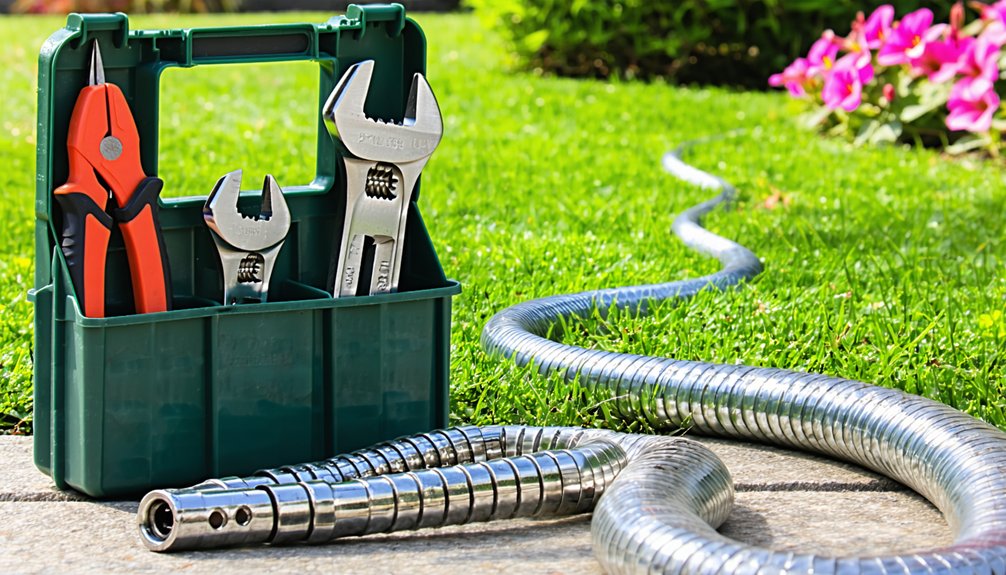Easy DIY tips for sewer line care include regularly inspecting drains for signs of wear, such as slow drainage and gurgling sounds. Using a mixture of baking soda and vinegar can effectively maintain clear sewer lines by breaking down grease and debris. Additionally, employing a drain snake can help resolve minor clogs before they escalate. Implementing these practical strategies enhances the integrity of plumbing systems, ensuring long-term functionality and minimizing risks of significant issues. Further insights can enhance maintenance techniques.
Regularly Inspect Your Drains
Regularly inspecting drains is an essential practice for maintaining the integrity of plumbing systems. Homeowners should routinely inspect their drains for early signs of wear, such as slow drainage or unusual gurgling sounds. These indicators may signify potential blockages that require immediate attention. Visible signs of buildup or clogs in drain openings, along with unpleasant odors, can suggest underlying issues within the plumbing system. Accessible areas, particularly under sinks and around toilets, should be checked for leaks or moisture, which may indicate sewer line problems. A flashlight can aid in examining the condition of pipes, allowing for the detection of corrosion, cracks, or root intrusion that could lead to blockages. Additionally, scheduling routine professional inspections annually guarantees thorough evaluations of the entire sewer system, as many issues may remain hidden without specialized equipment. Regular inspections empower homeowners to maintain their drainage systems effectively, preventing costly repairs and guaranteeing long-term functionality. Moreover, addressing common issues and signs early can help avoid more severe plumbing problems down the road.
Utilize Baking Soda and Vinegar
Maintaining clear sewer lines is essential for peak plumbing performance, and utilizing baking soda and vinegar offers an effective DIY solution for homeowners. This eco-friendly cleaning method involves pouring half a cup of baking soda followed by half a cup of vinegar down the drain. The resulting foamy reaction helps break down grease and other debris, effectively dislodging minor clogs and eliminating odors. For best results, allowing the mixture to sit for 30 minutes before flushing with hot water is recommended. This approach is safe for most plumbing systems and serves as a preventative measure against the corrosive effects of harsh chemical cleaners, which can damage pipes over time. To guarantee ongoing maintenance, homeowners should consider employing this DIY cleaning method monthly. By regularly using baking soda and vinegar, individuals can keep sewer lines in peak condition and reduce the likelihood of significant buildup.
Employ a Drain Snake for Minor Clogs
Employing a drain snake provides an effective method for homeowners to tackle minor clogs in their plumbing systems. This affordable tool is specifically designed to clear debris, making it an essential maintenance item. When using a drain snake, one must carefully insert it into the drain until resistance is felt, indicating a blockage. At this point, twisting or pushing the snake can help break up the clog. For high-traffic drains, regular use of a drain snake is advisable to prevent clogs caused by accumulated hair, soap, and food particles. It is vital to choose the right size; a smaller handheld snake works well for sinks and tubs, while a larger motorized version is better suited for main lines. Caution is paramount; excessive force or improper technique can lead to damaging pipes, resulting in costly repairs to the plumbing system.
Frequently Asked Questions
How to Clean Out a Sewer Line Yourself?
To clean out a sewer line, individuals can utilize plumbing tools like a drain snake for minor clogs. Regular toilet maintenance can be enhanced by pouring enzyme cleaners, promoting clog prevention. Performing a sewer inspection should be part of routine pipe maintenance, while flushing with a baking soda and vinegar mixture aids in combating sewer odors. Implementing these DIY plumbing hacks fosters effective emergency plumbing responses, ensuring a healthier plumbing system overall.
How Do You Make Homemade Sewer Pipe Cleaner?
To create a homemade drain cleaner, one can combine equal parts vinegar and baking soda. This natural unclogging method generates a foamy reaction that effectively breaks down grease and debris. For enhanced results, adding salt to the mixture can improve its cleaning power. Regular use of this biodegradable cleaner, alongside sewer line inspections and plumbing safety tips, serves as an essential preventative measure against clogs, ensuring effective pipe maintenance and reducing plumbing emergencies.
What Dissolves Toilet Paper Clogs in a Sewer Line?
To effectively dissolve toilet paper clogs in sewer lines, several methods can be employed for clog removal. A baking soda and vinegar mixture creates a foamy reaction, while hot water aids in softening the paper fibers. Enzyme cleaners serve as a natural remedy that digests organic matter gently, and chemical solutions can provide additional power. For stubborn clogs, plumbing tips suggest utilizing a toilet auger to physically remove blockages, enhancing sewer maintenance.
How Often Should You Hydro Jet Your Sewer Line?
The frequency recommendations for hydro jetting typically range from every 1 to 2 years, depending on various factors. Signs of clogging, such as slow drainage, may indicate the need for more frequent service. Hydro jetting benefits include extending sewer line lifespan and minimizing costly repairs. Pipe material considerations, environmental impact, and cost analysis are essential when planning maintenance. Consulting professional services can enhance preventive measures and optimize DIY maintenance tips for effective sewer care.



